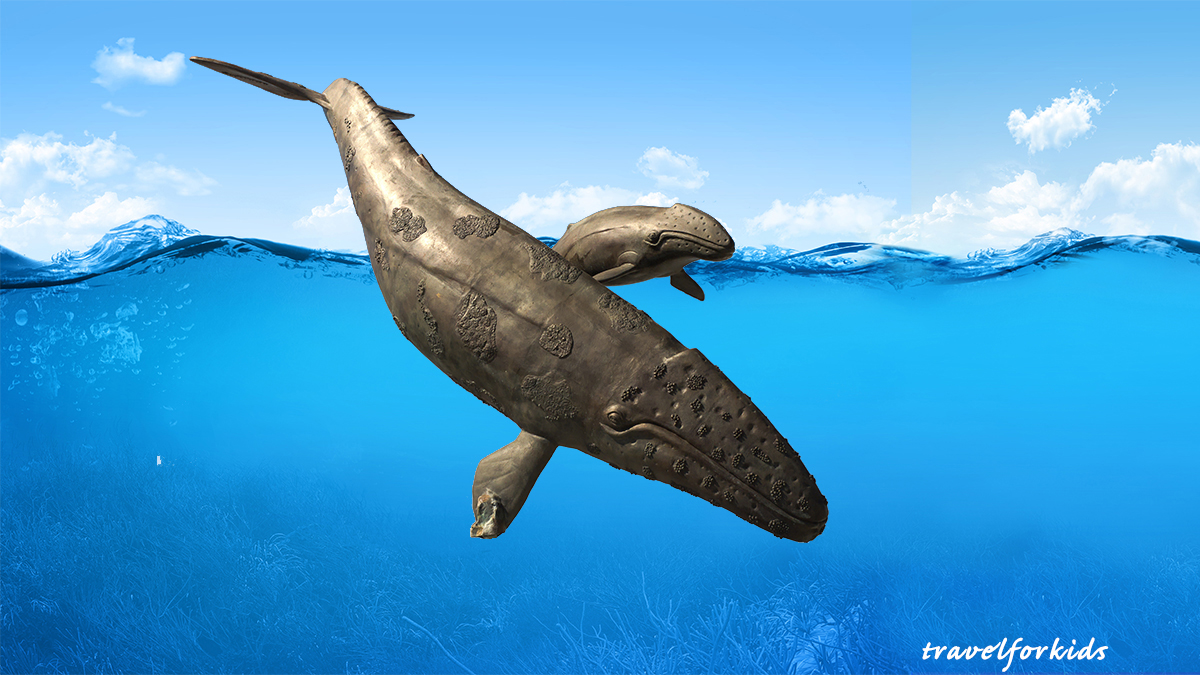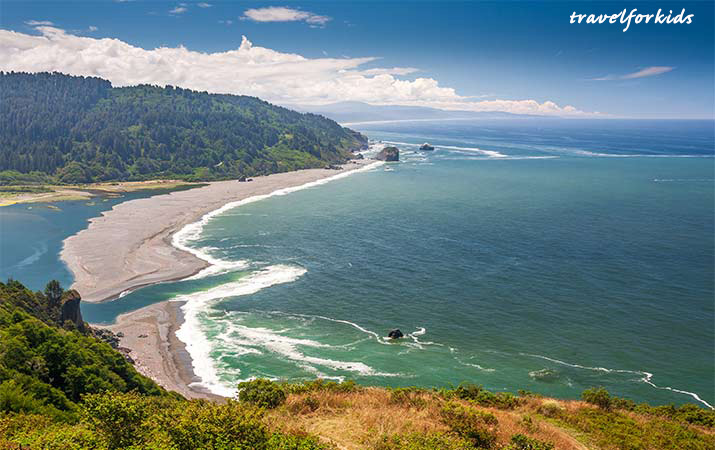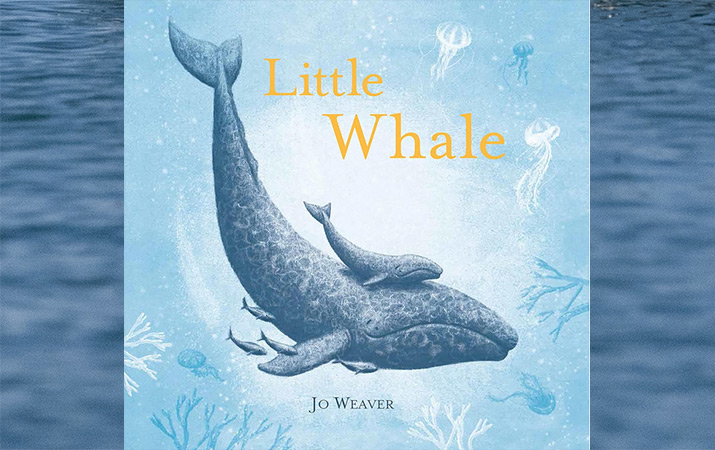
It winter and spring season, and gray whales migrate south from Alaska to Mexico, and then north, returning to Alaska.
Each year, gray whales in the Pacific Ocean take an extraordinary round trip 9,000- 13,000 miles, one of the longest mammal migrations.
Gray whale migration begins in October or November around Alaska, the whales swim south along the west coast to lagoons in Baja Mexico. There they mate, give birth; then a couple of months later, begin the migration back to their feeding grounds in oceans around Alaska.
Newborn calves accompany their moms on the long voyage north (when calves get tired they rest on mom’s back). Gray whales travel in small pods of 3 – 7 whales, swimming close to the coastline, typically 1 – 3 miles offshore.
Tips for onshore gray whale watching
Bring binoculars!
Stay high up on bluffs and coastal promontories with panoramic views of the ocean, not down down the beach.
Weather –
For best viewing, go out on a clear day, not windy (choppy waves make it harder to see the whales).
Seasons for onshore viewing –
Gray whales migrate in winter and spring months. Overall, during spring months, March to May, weather is better, and whales are closer to shore.
Call visitor centers or check online to find current information about gray whale sightings.
In southern California, winter can be warm and sunny, so look for whales in December to February (whales going south) and as well as spring months (whales going north).
Northern California, on clear days in winter, take advantage December to February also. For spring migration, March and April is good time to see whales.
In Oregon and Washington, rainy, windy winter weather isn’t optimal for onshore whale watching. Gray whales start to arrive in March, April and May whales are heading north.
Around Newport and Depoe Bay in Oregon, resident gray whales don’t migrate north to Alaska in spring. They stay around the coast in summer and fall, join the migration going south in winter.
Spotting gray whales –
Gray whales dive down to the bottom to feed in the ocean, but they come to the surface to breathe.
Look for whales just beyond the waves breaking onshore, spouting on the surface (misty air expelled from the blowhole), and breaching (leaping from the water, then splashing back down).
If you see a whale tail, it’s diving down, and may stay underwater for several (5 – 10) minutes. Scan the waves in the direction it’s heading (north or south), to spot where it might resurface to breathe.
Even if you don’t see any gray whales, look for other marine life – humpback whales (very acrobatic), dolphins, harbor seals and sea lions. In Oregon and Washington you might even see orcas too (orcas hunt the gray whales).
Tip: Whale watching is just one of many fun things to do with kids on scenic West Coast beaches – go tide pooling, visit a lighthouse, hike coastal trails, build driftwood forts, fly kites. Bring snacks and lunch, there’s no rush watching for whales.
California
San Diego – Point Loma, Cabrillo National Monument
Dana Point – Dana Point Headlands Conservation Area
Malibu – Point Dume Nature Preserve
Morro Bay – Montana de Oro State Park, Ocean Bluff Trail
Bodega Bay – Bodega Head (Westshore Rd. parking)
Point Reyes National Seashore – Chimney Rock, Point Reyes Lighthouse
Fort Ross State Historic Park – Trail overlooking the ocean
Redwood Coast – Klamath River Overlook
Whale watching cruises depart from San Diego Harbor, Dana Point, Monterey, Santa Cruz, San Francisco Fisherman’s Wharf.
Oregon
Cannon Beach – Ecola State Park, Ecola Point
Depoe Bay – Whale Watching Center
Newport – Yaquina Head
Florence – Hecata Head Lighthouse
Cape Blanco – Cape Blanco Lighthouse
Depoe Bay and Yaquina Head are great viewpoints for whale watching, as there are resident gray whales off the coast year round.
Whale watching cruises depart from Depoe Bay and Newport.
Washington
Cape Disappointment – Lewis and Clark Interpretive Center
Westport – Westport jetty lookout tower
Kalaloch – Bluffs above the beach
Whale watching cruises depart from Westport, and Friday Harbor on San Juan Island,
Children’s books
- Little Whale by Jo Weaver
- A baby gray whale follows her mother on a long journey, through shimmering seas, to their home in the north. Gorgeous artwork portrays wonders of gray whales and their yearly migration. (Picture book)
- When Whales Cross the Sea by Sharon Katz Cooper, Tom Leonard.
- In fall, a gray whale leaves the Arctic to begin migration south. She feeds non-stop, building up energy and blubber for the long voyage. After two months, the whale arrives in the warm water of Baja, and gives birth to a 1,000 pound baby whale. Now it’s time for mother whale to feed her calf, show him how to look for food, and start the trip north. (Picture book)
- Baby Whale’s Long Swim by Connie and Peter Roop.
- It’s winter in Mexico, a mother gray whale has a new calf. When it’s spring, it’s time to swim north. Mother and calf life their heads out to the water, roll, wave their fins, when the baby whale is tired, he rests on his mother’s back. At last they reach Alaska, and it’s summer. (Easy reader)
- On the Move: Mass Migrations by Scotti Cohn, Susan Detwiler.
- Not only about gray whales migration, find out about animals that travel long distances for food, a different climate, or part of the cycle of life. Find out about migrations of gray whales, monarch butterflies, elephant seals, polar bears, salamanders, cranes, horseshoe crabs, and more. Illustrations capture mystery of animals “on the move.” (Picture book)
Conservation
Gray whales are an ancient species, they’ve been around for millions of years, but came close to extinction.
Today, gray whales only migrate in northern and eastern Pacific Ocean.
Starting in the mid 19th century, whaling ship expeditions massively hunted the gray whales, and by early 20th century, gray whales were nearly extinct.
In 1946, laws banned commercial hunting of gray whales, and sanctuaries for breeding lagoons in Baja were created. More conservation efforts, such as the Marine Mammal Protection Act, and marine sanctuaries reduce effects of shipping and fishing that can harm gray whales.
Now it’s estimated 20,000+ gray whales migrate each year.
Gray whales are an important part of a huge ocean community, and we are fortunate to have the opportunity to see these magnificent creatures in the blue waters of the Pacific.
Editor’s note: Growing up in southern California, I once saw a mother gray whale and her calf, resting in turquoise sparkling waters of a cove at Laguna Beach. Unforgettable.


